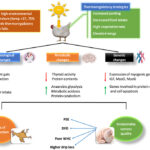1. Feed Additives
Feed additives are substances added to poultry feed to improve its quality, enhance performance, prevent diseases, and improve the efficiency of feed utilization. They include nutritional additives (like vitamins and amino acids) and non-nutritional additives (like antibiotics, enzymes, and antioxidants).
2. Antibiotics
Antibiotics are used in poultry to:
- Treat and prevent bacterial infections.
- Promote growth by enhancing feed efficiency.
Concerns:
- Overuse can lead to antibiotic-resistant bacteria.
- Residues in meat and eggs pose a risk to human health.
- Many countries now regulate or ban antibiotic growth promoters.
3. Coccidiostats
Coccidiostats are drugs added to poultry feed to prevent or control coccidiosis, a parasitic disease caused by Eimeria spp.
Types:
- Ionophores (e.g., monensin, salinomycin)
- Synthetic chemicals (e.g., amprolium)
Usage Strategy:
- Rotation and shuttle programs to avoid resistance development.
4. Antioxidants
These prevent oxidative damage in feed and poultry tissues.
Types:
- Natural: Vitamin E, selenium
- Synthetic: BHA, BHT, ethoxyquin
Functions:
- Preserve feed quality.
- Improve immunity and meat quality.
5. Probiotics
Probiotics are live beneficial microorganisms that improve gut health and balance the intestinal flora.
Common Strains:
- Lactobacillus, Bifidobacterium, Bacillus subtilis
Benefits:
- Enhance nutrient absorption.
- Prevent pathogenic colonization.
- Improve immune responses.
6. Enzymes
Enzymes improve nutrient digestibility by breaking down anti-nutritional factors or complex molecules.
Common Enzymes:
- Phytase (improves phosphorus availability)
- Xylanase, beta-glucanase (breaks down non-starch polysaccharides)
Advantages:
- Better feed efficiency.
- Reduced nutrient excretion.
7. Metabolic Antagonisms and Incompatibilities in Mixed Feed
Certain feed ingredients or additives can interact negatively, affecting metabolism.
Examples:
- Excess calcium reduces phosphorus availability.
- High copper inhibits zinc absorption.
- Vitamin degradation due to mineral interactions.
Solutions:
- Balanced formulation and proper storage.
- Use of chelated minerals.
8. Stability and Availability
Stability: Refers to the shelf life and integrity of feed components.
Availability: Refers to the bioavailability of nutrients to the animal.
Factors Affecting Stability:
- Temperature, humidity, light, pH, feed processing methods.
Example:
- Vitamin A is unstable under high heat and light.
9. Vitamins and Vitamin Antagonists
Vitamins are essential micronutrients for growth, immunity, and metabolism.
Vitamin Antagonists:
- Compounds that interfere with vitamin absorption or utilization.
Examples:
- Thiaminase (destroys vitamin B1)
- Sulfa drugs (inhibit folic acid synthesis)
10. Amino Acids
Amino acids are building blocks of protein and essential for growth, reproduction, and maintenance.
Essential Amino Acids in Poultry:
- Lysine, methionine, threonine, tryptophan
Imbalances or deficiencies can cause poor growth, feathering, or immune suppression.
11. Antimetabolites
Antimetabolites mimic normal nutrients but interfere with normal metabolic functions.
Example:
- Aminopterin (folic acid antagonist)
- 6-mercaptopurine (purine antagonist)
They are generally toxic and used with caution in research or treatment.
12. Goitrogens
Goitrogens are substances that interfere with thyroid hormone synthesis.
Sources:
- Rapeseed meal, soybeans (contain glucosinolates or isoflavones)
Effects:
- Goiter (enlarged thyroid)
- Poor growth and metabolic issues
Prevention:
- Heat treatment to deactivate goitrogens
- Iodine supplementation
13. Drug Toxicities
Toxic effects occur when drugs are overdosed, misused, or improperly withdrawn.
Examples:
- Ionophore toxicity in layers (can cause paralysis)
- Nitrofurans and chloramphenicol (banned due to human health risks)
Prevention:
- Strict adherence to dosage and withdrawal periods.
14. Toxic Substances in Poultry Feed
Various natural and chemical contaminants can be toxic.
Examples:
- Mycotoxins: Aflatoxins, ochratoxins from moldy grains.
- Pesticide residues: From improperly stored or treated feed.
- Heavy metals: Lead, mercury, cadmium from contaminated water/feed.
- Anti-nutritional factors: Tannins, trypsin inhibitors in raw legumes.
Management:
- Regular feed testing.
- Use of toxin binders.
- Proper storage and sourcing.




bn1mau
bn1mau